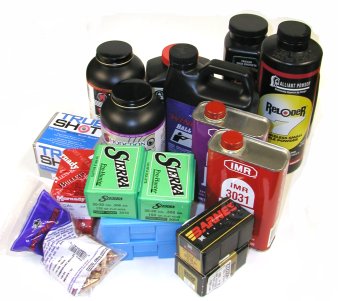 The 30-30 Winchester ( .30-30 WCF, 30 Winchester and 7.62x51Rmm) has been around since 1895. How many exciting discoveries can be made through aggressive handloading? In terms of velocity, probably none. 150 grain bullets will max at about 2,350 fps, 170 grain loads perhaps 150 fps less. Even light 100 grain bullets will peak at about 2,600 fps before running out of propellant, or up against the SAAMI 42,000 PSI maximum pressure ceiling. In terms of reduced cost, accuracy, optimal bullet construction, and powder selection, there is plenty of potential to extract. For the short range hunter and recreational target shooter, the compact Winchester Model 94 and the .30-30 WCF cartridge combination offers as much potential as a WSM or other cartridges of recent release.
The 30-30 Winchester ( .30-30 WCF, 30 Winchester and 7.62x51Rmm) has been around since 1895. How many exciting discoveries can be made through aggressive handloading? In terms of velocity, probably none. 150 grain bullets will max at about 2,350 fps, 170 grain loads perhaps 150 fps less. Even light 100 grain bullets will peak at about 2,600 fps before running out of propellant, or up against the SAAMI 42,000 PSI maximum pressure ceiling. In terms of reduced cost, accuracy, optimal bullet construction, and powder selection, there is plenty of potential to extract. For the short range hunter and recreational target shooter, the compact Winchester Model 94 and the .30-30 WCF cartridge combination offers as much potential as a WSM or other cartridges of recent release.
A reason for renewed interest in the combination
We have grandchildren, or at least these little people who keep showing up at our house to play video games and make field trips to Toys R Us. They apparently like my wife and I a lot, as their parents frequently call to tell us how much the little guys miss us and want to visit and spend the night. We return the favor by teaching the kids how to burp on demand, run heavy machinery and be sarcastic. Then we feed them lots of ice cream and candy, and let them run around in circles about 15 minutes before they leave for home. Eventually, the monkey trio will be old enough and stable enough to learn firearm safety and that a firearm in the hands of a thinking person can provide great recreation. When the experience gets beyond rim fire, the little lever action rifle, with low recoiling cartridge would leave a great first impression on a relatively new shooter. I know it worked with their fathers.
Powder choices…too many to List
I’ve really enjoyed the past couple of weeks of work on this project. I typically spend a good deal of time with more specialized cartridges, particularly those that have large case capacity and operate at high velocity. The pursuit of high velocity means fewer bullet and powder choices and sometimes less than pleasant range sessions during load development. When I load for the .338-378 Weatherby, I realistically have three powder choices; Reloder 25, IMR 7828 and Retumbo. When I was selecting powder for the .30-30 WCF article, I picked eleven as a cross section selection of powders suitable for my purposes, but there were many others from which to choose. In order of slower to faster burn rate they are:
-
Hodgdon BL-C(2) – Spherical Powder, the original military powder for the 7.62 NATO round. High end of medium burn rate used in everything from the .17 Remington to the .308 Winchester.
-
Win 748 – Ball powder, medium burn rate for use in 223 Remington, 30-30 WCF, 308 Winchester and 458 Winchester Magnums.
-
Hodgdon Varget – Extruded Powder, slow end of medium burn rate .223 Remington to .375 H&H. The first Hodgdon Extreme powder that offers uniform performance over a wide temp range.
-
Reloder 15 – Extruded, medium burn rate, wide operating temperature range, good for large capacity small bore cartridges and moderate capacity .30 caliber cases.
-
RamShot TAC – Medium burn rate, spherical powder, small bore-high capacity cartridges through moderate bore:capacity ratio cases.
-
Hodgdon Benchmark – Extreme Extruded powder, medium burn rate, typically used in .17 Remington through .308 Winchester type capacity cases.
-
IMR 3031 – Medium burn rate, extruded powder, good from small bore to .30-30 WCF and reduced loads for larger capacity cartridges.
-
IMR 4895 – Small grain extruded powder, fast end of medium burn rate, good from small bore to .30-06 Springfield.
-
Reloder 7 – Extruded powder, fast end of medium burn rate. Typically used for small capacity rifle cases, and low bore:capacity ratio cases.
-
Win 296 – Relatively fast burn rate, generally for use in large handgun cartridges and .410 Shotgun loads. Ball powder.
-
H 110 – A relatively fast powder typically used in magnum handguns and .410 Shotgun loads. It is a spherical powder.
There are some discrepancies amongst tables produced by component and powder suppliers in regard to burn rate, not within their own product lines, but when merging powder from multiple sources. Powder performance varies over time and, sometimes, the difference in speed from one to another is imperceptible. For the purpose of this article, the accuracy of the listing order should not be a problem.
Primers
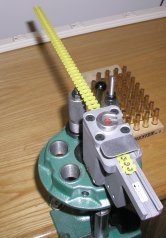 Yes, by all means use them, I did is almost all of the handloads assembled during this project. When I grew tired of primer flipping, primer contamination, jammed primer gravity and shuttle feeds, and trying to find one of those little buggers in the dust under the book shelf, I changed to CCI primers and APS priming. The primers are mounted in plastic feed strips that keep fingers off of primer compound. The APS bench mounted press is compact, fast and allows the operator to feel correctly seated primers, although the press does have a mechanical stop to simplify the process of assuring primers are set to a depth approximately .004″ below case rim height.
Yes, by all means use them, I did is almost all of the handloads assembled during this project. When I grew tired of primer flipping, primer contamination, jammed primer gravity and shuttle feeds, and trying to find one of those little buggers in the dust under the book shelf, I changed to CCI primers and APS priming. The primers are mounted in plastic feed strips that keep fingers off of primer compound. The APS bench mounted press is compact, fast and allows the operator to feel correctly seated primers, although the press does have a mechanical stop to simplify the process of assuring primers are set to a depth approximately .004″ below case rim height.
Family members, attempting to keep me busy and out of trouble, had given me both press mounted and hand operated priming APS tools, both of which were used during the course of this project. There is nothing wrong with either of these tools, but I couldn’t find a circumstance within my handloading activity that would warrant more than the bench mounted press. The press mounted APS tool takes over the shell holder position on the press, so the press can’t be used for any other purpose while priming. In addition, the size of the tool and clearance required for primer feeding prevent adjacent die positions from being utilized in multi-station presses. I do not handload at remote locations, but I thought the handheld might be useful when assembling development loads with differing primer types; large rifle primers in the press, magnum primers in the handheld, but that violates my basic rule of one type of primer and one type of powder on the bench at any given time. Again, it isn’t that these tools are bad, they are just redundant for someone who already owns a bench mounted press. The bench mounted APS press runs about $75 through discount retailers, the press mounted tool runs about $55, the handheld approximately $35.
Winchester 748 powder, and perhaps other full case or compressed load selections occasionally indicate the use of magnum primers. If you have ever disassembled old compressed loads with small granular powder, you may have noticed the powder almost cakes in the case and into a column of powder that might be hard to uniformly ignite. Still, I did not use magnum primers in any of the loads that were part of this project. There is a theory that a hot primer in a compressed load situation could force the powder against the bullet heel prior to ignition of the powder, driving the bullet out into the firearm’s bore. The result would be powder burning within an increased area, which would reduce chamber pressure and, subsequently, velocity. I don’t know…possibly. I use standard primers because, as a practical matter, I have not been able to see a difference between the two, at least in terms of reliability of ignition or performance in velocity.
If you have a copy of QuickLOAD, and find yourself with a choice of watching politically corrected TV or poking yourself in the eye with a sharp stick, try running some of the top load in bullet manufacturers’ handload manuals that have a special “magnum primer” notation in a data table that otherwise specifies standard primers. I always come up with a significantly over pressure result, which makes me wonder if the theory of primer displaced bullets has merit, or if the compression alters the powder’s burn rate.
Cartridge Cases and Crimping

The first notable characteristic of a .30-30 WCF case is that it is thin at the case neck and mouth. Remington case neck wall thickness is approximately .010″, Winchester brass is .011″. By comparison Winchester 270 WSM brass is .014″ thick, 257 Weatherby Magnum .015″, Remington .25-06 brass .013″, Winchester .243 brass .015″. Interestingly, the low pressure .45-70 case from Winchester and Remington are .011″ and .010″ respectively. The cartridge drawings for the .30-30 WCF seems to imply a .012″ material thickness at the case neck so maybe current production is a little thin, but cases intended to experience moderate pressure seem to be a little light in construction.
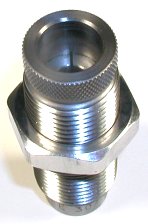 New brass, regardless cartridge or manufacturer, needs work. Typically new brass will be short and varied in length, the case mouths will be deformed (at times enough to prevent bullet seating) and flash holes may be obstructed. Resizing and pulling an expander ball back through the case mouth tends to make new brass a little longer and more uniform in length, but not uniform enough to avoid case length trimming where roll crimps are to be used.
New brass, regardless cartridge or manufacturer, needs work. Typically new brass will be short and varied in length, the case mouths will be deformed (at times enough to prevent bullet seating) and flash holes may be obstructed. Resizing and pulling an expander ball back through the case mouth tends to make new brass a little longer and more uniform in length, but not uniform enough to avoid case length trimming where roll crimps are to be used.
A crimp die is set up on a sample case mouth and will crimp based on that reference, regardless actual case length. Short cases light crimp, long cases over-crimp or buckle and, even when the differences are minor, the varying tension results in a lack of uniform cartridge performance. This is why case trimming to a uniform length is necessary. The lot of the new Remington cases I had purchased came in between 2.034~2.038″ in length. New Winchester brass ran 2.024~2.027″. Generally, mainstream handloading manuals indicate a maximum case length of 2.039″ and a “trim to” length of 2.029″. The SAAMI case spec is 2.0395″ max – .020″ which means brass can be as short as 2.019″. I trimmed all of the brass I has to 2.024″ for the sake of uniformity, still well within spec for minimum case length. I elected to use a Lee Factory Crimp die to assemble these handloads, the same type I use when I load .45-70 Government ammo. The collet crimp works well in terms of bullet retention and seems to promote more uniform cartridge to cartridge velocity performance. While I’ve utilized Lee equipment in the past while experimenting with bullet casting as an example, my assessment is that it is designed for low cost and this shows in the way the equipment functions. This is not the case with the factory crimp dies, they are excellent, and Lee will make custom sets for unlisted cartridges for a modest fee.
Bullets
Both the Winchester and Marlin lever guns have tubular magazines, thereby negating the use of pointed bullets. Fortunately, virtually all major manufacturers offer their own proprietary bullet construction in a flat tip or shallow radius point configuration for safe use in there rifles. For handloaders, there are lots of inexpensive cast bullets available, the cartridge can be light loaded for recreational plinking and there are 100, 110, and 125 grain bullets for varmint popping. Just don’t expect great things to happen in terms of flat trajectory, or tight group consistency. The little 110 grain bullet would be best served with a 1:21″ twist, not the 1:12″ twist found in the current Model 94 and, with a bullet B.C. of only .150, these light weights have approximately the same 200 yard outer limit range as the 150-170 grain bullets. In any event, the lever guns are at their best when loaded with 150 and 170 grain round or flat points and used to down deer, black bear, pigs and similar size range of your better tasting mammals. For the sake of this project, I limited my selection to eleven bullets….to go with the eleven types of powder. Listed left to right.

Hornady 110
Barnes 150
Winchester 150 Sierra 150
Remington 150
Speer 150
Remington 170
Hornady 170
Sierra 170
Nosler 170
True Shot 170
With the exception of the little 110 grain Hornady, all of the others were listed specifically for use with the .30-30 WCF in lever action rifles. The tips are either flat or have a relatively shallow radius to make them safe in tubular magazines. I think it is great that 30-30 WCF shooters have a solid choice of jacket types and bullet construction from the Barnes solid copper bullet to the Nosler Partition. The only oddity in the bunch was the Barnes 150 grain with its cannelure groove located far up the bullet shank. The result is deep seating, and a loss of case capacity with could result in an increase in breech pressure and reduce the bullet’s potential.

The effect of deep seating is considerable when it comes to acceptable charges and pressure. As an example, a 150 grain FN Sierra bullet, seated .375″ into the case will generate approximately 42,000 PSI of pressure and 2,371fps of velocity from 33.2 grains of IMR 3031 powder. Leaving the powder charge as is, and inserting a Barnes seated with .560″ of the bullet shank into the case would generate approximately 55,000 PSI of breech pressure, which is approximately 13,000 PSI above SAAMI maximum pressure for the .30-30 WCF. Reducing the powder charge to 30.3 grains of the same powder brings pressure back down to approximately 42,000 PSI, but velocity drops to 2,290 fps. I have samples of both bullets and appropriate handloads that are part of the test population that will see the range and a chronograph. I have a call in to Barnes and I will update if I learn something about this arrangement that is not obvious. I also have questions about application as this is a deep hollow point in an otherwise solid copper bullet.
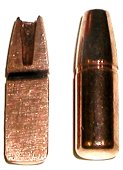 Bullet construction was relatively uniform lead core, one piece jacket, with the exception of the Barnes 150 grain and the Nosler Partition. The Barnes X bullet series is of solid copper construction, most designed for high velocity applications have a relatively small hollow point channel running from tip through the length of the ogive. As an example, the 7mm Barnes X has a .035″ opening, the .416 Barnes X a .080″ opening. The .30-30 WCF .308 bullet has a .140″ opening and the .45-70 type .458″ bullets a .250″ opening. The Barnes bullet is designed to expand relatively easily to the shank, then hang together with minimal deformation. I’ve always found Barnes bullets to be accurate, group well and expand while holding together at near and distant ranges. At 50¢, they are a little pricy, but they are for hunting where few shots are fired, and opportunities are costly and hard to come by. Barnes also offers a 165 grain flat nose bullet, but I could not afford to buy more.
Bullet construction was relatively uniform lead core, one piece jacket, with the exception of the Barnes 150 grain and the Nosler Partition. The Barnes X bullet series is of solid copper construction, most designed for high velocity applications have a relatively small hollow point channel running from tip through the length of the ogive. As an example, the 7mm Barnes X has a .035″ opening, the .416 Barnes X a .080″ opening. The .30-30 WCF .308 bullet has a .140″ opening and the .45-70 type .458″ bullets a .250″ opening. The Barnes bullet is designed to expand relatively easily to the shank, then hang together with minimal deformation. I’ve always found Barnes bullets to be accurate, group well and expand while holding together at near and distant ranges. At 50¢, they are a little pricy, but they are for hunting where few shots are fired, and opportunities are costly and hard to come by. Barnes also offers a 165 grain flat nose bullet, but I could not afford to buy more.
![]() The Nosler Partition may not be all that different from the Barnes in concept. Yes, I know the Barnes is not a jacketed bullet. The Nosler has a relatively fragile forward jacket and a stout rear partition that is made to hold together. The construction isn’t so much different from the Swift A Frame, or some of the old European “H” construction products. The Nosler is .050″ at the heel, which is open to permit lead filling, about .090″ at the web of the partition, and approximately .020″ where it tapers into the open tip.
The Nosler Partition may not be all that different from the Barnes in concept. Yes, I know the Barnes is not a jacketed bullet. The Nosler has a relatively fragile forward jacket and a stout rear partition that is made to hold together. The construction isn’t so much different from the Swift A Frame, or some of the old European “H” construction products. The Nosler is .050″ at the heel, which is open to permit lead filling, about .090″ at the web of the partition, and approximately .020″ where it tapers into the open tip.
 The Hornady bullet has an obvious advantage, it’s bigger, at least as long as I’m the photographer. This is a single piece jacket, much like the balance of the bullets outside of the Barnes and Nosler. The Hornady jacket is approximately .040″ thick at the heal and .020″ near the open tip. The cross section of other one piece jacket bullets; 170 and 150 Remington Core Lokt, the Speer Hot Core and the Winchester Power Point are all very much the same with a .040″ thickness at the heel and approximately .020″ thinning toward the nose. The Remington product seemed to have the most exposed lead, where the Hornady and Speer bullets had the least. This is the point where I typically would say, so “Buy the cheapo Remington bulk bullets, I do”, but I won’t. Even the lowly .30-30 WCF slug is traveling at MACH 2 where little things, in terms of bullet jacket coverage, could mean a lot. Then again, I’ve used cheapo Core Lokt bullets on large boar and distant deer and the Remington bullets exhibited deep penetration and good controlled expansion.
The Hornady bullet has an obvious advantage, it’s bigger, at least as long as I’m the photographer. This is a single piece jacket, much like the balance of the bullets outside of the Barnes and Nosler. The Hornady jacket is approximately .040″ thick at the heal and .020″ near the open tip. The cross section of other one piece jacket bullets; 170 and 150 Remington Core Lokt, the Speer Hot Core and the Winchester Power Point are all very much the same with a .040″ thickness at the heel and approximately .020″ thinning toward the nose. The Remington product seemed to have the most exposed lead, where the Hornady and Speer bullets had the least. This is the point where I typically would say, so “Buy the cheapo Remington bulk bullets, I do”, but I won’t. Even the lowly .30-30 WCF slug is traveling at MACH 2 where little things, in terms of bullet jacket coverage, could mean a lot. Then again, I’ve used cheapo Core Lokt bullets on large boar and distant deer and the Remington bullets exhibited deep penetration and good controlled expansion.
![]()
The 110 grain Hornady had an interesting jacket; .030″ pretty much all the way around with a small amount of exposed lead. This seemed to be a pretty tough set up for what must be intended for varmint use, but it also listed up through .30-06 Springfield applications with significantly higher velocity.
Zero distances, point blank range and practical shooting distances
Selection of a bullet for the .30-30 WCF based upon ballistic coefficient is probably not necessary. The blunt tip requirement makes every bullet a virtual flying door. If I fired two different .308″ 150 grain bullets at 2400 fps, from a rifles sighted in at 100 yards; a 150 grain Barnes X and a 150 grain Barnes X flat nose, the first would drop 19.8″ at 300 yards, the second 23.5 inches. Probably not a great difference, and one that could be narrowed by selecting an appropriate zero for each. However, regardless how well the curve of trajectory might be managed through setting an appropriate zero, the pointed bullet would always retain over 300 fps more velocity than the flat nose projectile, and would yield almost 50% more energy at a 300 yard point of impact. This would of course be a concern if the .30-30 WCF were intended to be a 300 yard gun. Once the probable impact range is reduced to a realistic 100~150 yards, the difference in terminal ballistics is not of consequence so, within reason, bullet shape is not a consideration for .30-30 WCF shooters.
As a practical matter, the .30-30 WCF is a 180 yard point blank rifle, if a combined bullet rise and fall within a band of 3″ is satisfactory for 150 grain loads. The 170 grain loads are good for 170 yards without having to compensate in elevation for distance. In both cases the highest the bullet rises above the line of sight, maximum ordinate, is 1.5″. The point blank range is beyond the useful hunting range of the firearm.
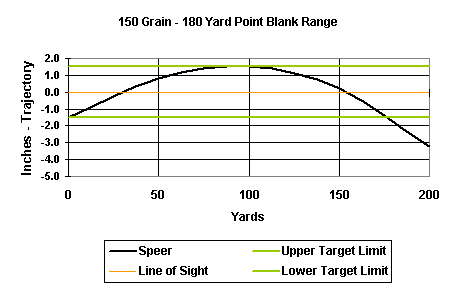
The two green lines labeled “Upper Target Limit” and “Lower Target Limit” represent a critical target area of 3″; 1.5″ above the line of sight, 1.5″ below the line of sight. The amber line is “Line of Sight”, in this case, the straight line passing through the scope on the rifle to the point of aim at the target. The loping black line is the bullet flight path which starts its journey -1.5″ below the line of sight, as the center of the bore is 1.5 inches below the center line of the scope. Sighting in a rifle is like adjusting for pitching horse shoes, the person pitches higher than the intended point of impact because gravity will be pulling down on the shoe while it is in transit. The farther the intended point of impact, the higher the shoe is lofted when tossed. Bullet trajectory is the exact same thing. The bullet must pass above the straight line of sight that exists between the shooter and target, so that even after the effects of gravity on the bullet, the bullet will still end up on target. The point where the bullet intersects the line of sight on the way up is called near zero, the point where it intersects the line of sight on the way down is called far zero. In this example, near zero occurs at 28 yards, far zero at 155 yards. Theoretically, a shooter could zero this load at only 28 yards where the bullet first rises to cross the line of sight, be on zero again at 155 yards when the bullet descends to cross the line of sight again, and be target within an inch and one half either way out to 180 yards. Not too shabby for an old clunker round. No legend lines are missing, the trajectories overlap.
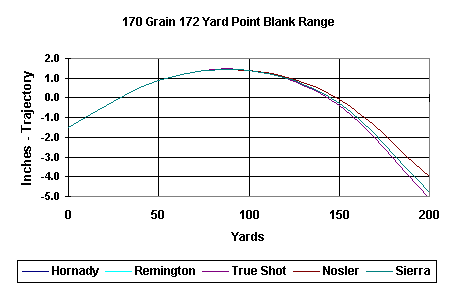
The 170 grain bullet yields a 172 yard point blank range. Near zero is 27 yards, far zero 149, target size 3″. There is essentially the same potential with both bullet weights. I am not suggesting all bullets fly the same path and exhibit the same drop characteristics based upon drag. I am suggesting that setting a proper zero for each bullet would produce a very similar trajectory. As a side note, the little 110 grain bullet, buzzing along at 2600 fps MV only extends point blank out to 189 yards with a 30/164 yard zero. Altering trajectories are about tricking gravity. In a vacuum, the time it would take a bullet to fall to the earth from a person’s hand held 3′ off the ground, is the same amount of time it would take a bullet to fall to the ground if fired from a rifle held parallel to, and 3′ off the ground. A bullet begins to fall the instant it leaves the barrel as a result of gravitational pull. Changing the angle of inclination of a gun barrel, or varying velocity are the only two factors that will alter a given bullet’s point of impact. OK, you can wake up now, I’m done droning on and on about the obvious.
Summary
I guess the thought I’m taking away from what I’ve encountered so far, is that the .30-30 WCF may be archaic, but certainly not obsolete. Generally, firearms chambered for the cartridge are very much appropriate for the cartridge as well as the combination’s probable use; the combination fits many hunting and recreational shooting circumstances. The only remaining area to be defined is accuracy and shot placement. I will have the concluding handload and range results up for the next and final installment.
More “The Ultimate Woods Rifle”:
The Ultimate Woods Rifle – Part I
The Ultimate Woods Rifle – Part II
The Ultimate Woods Rifle – Part III
Handload Data 30-30 WCF
Thanks,
Joe

Email Notification